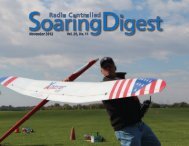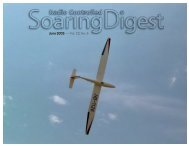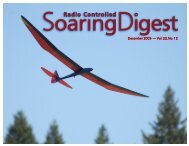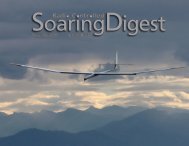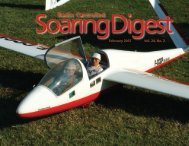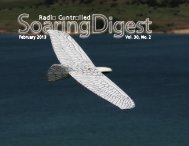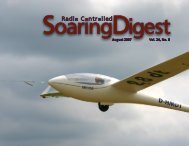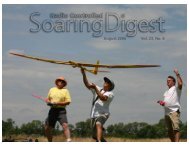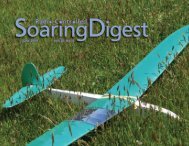4/03 RCSD - RC Soaring Digest - Rcsoaring.com
4/03 RCSD - RC Soaring Digest - Rcsoaring.com
4/03 RCSD - RC Soaring Digest - Rcsoaring.com
You also want an ePaper? Increase the reach of your titles
YUMPU automatically turns print PDFs into web optimized ePapers that Google loves.
GORDY’S TRAVELS<br />
Once you have noticed all you feel you<br />
can, make a search pattern plan, and<br />
follow it. It’s a big ‘Duh!’ if the plane<br />
before you went left and it sunk like a<br />
rock, pretty much assured of a spectacular<br />
one minute flight; you should<br />
choose a right turn off of launch.<br />
If there is a gaggle of planes in great<br />
lift, definitely do a ‘turn and burn’ off<br />
of the launch to get over that way.<br />
Once there, don’t be in a rush to get<br />
right in with them. Move past them to<br />
see if they are really just on the front<br />
edge of the core, or the back edge. If<br />
heading to a gaggle, do not take your<br />
eyes off of your plane, and advise your<br />
timer to do the same. It’s easy to lose<br />
which model is which.<br />
Recognizing lift<br />
Gordy Stahl<br />
Louisville, Kentucky<br />
GordySoar@aol.<strong>com</strong><br />
April 20<strong>03</strong><br />
Ten Tips That You Have Found Lift!<br />
Pretty often during my travels to<br />
your flying sites, I notice that pilots<br />
often launch through lift, fly through<br />
lift, fly away from lift or circle on the<br />
edge of lift... That’s okay if I am flying<br />
against them in a contest, but mostly<br />
it’s frustrating because I know I have<br />
done it for years myself.<br />
With all my flying you’d think that I<br />
would never miss my times or a<br />
landing but, in fact, like most of us<br />
mortals, sometimes I head the wrong<br />
way too or do a dumb thumb on<br />
approach.<br />
But one of the benefits of flying so<br />
often is that my frustration inspired<br />
me to identify cues and hopefully be<br />
able to explain them to the rest of us -<br />
not something the soaring legends are<br />
good at. They’re great sailplane pilots<br />
but not very often talkers.<br />
So let’s talk!<br />
Devise a flight plan<br />
Prior to launching (and this assumes<br />
you have read and put into practice the<br />
things I have written prior about trim,<br />
balance and its effects on reading air)<br />
take a look around the flying site. Look<br />
for the obvious signs like birds circling,<br />
dust devils, big dark clouds, or one<br />
group of trees moving on a tree line.<br />
Look for a tilled black field, or a big<br />
building that might be collecting heat.<br />
Duh, look at what other planes are<br />
doing, but don’t count on them to go<br />
to lift. Watch their travel path to see<br />
what kind of air they are passing<br />
through, as in did you see them<br />
wobble, or perk up their tails, or get<br />
sluggish and droop tailed? Take the<br />
wind speed into consideration too; it<br />
could mean that, once in lift, you will<br />
have to aggressively bank and crank,<br />
with tight moving circles to stay in the<br />
core.<br />
If you read my previous articles, this<br />
part is redundant, but important. If<br />
your model is balanced (As opposed<br />
to, “I set the CG according to the plane<br />
with a micrometer.”) then when it is in<br />
lift it will signal and confirm. It will<br />
signal via the tail popping up and the<br />
controls getting really lively. Once you<br />
feel that is the case, then by simply<br />
hitting your rudder either direction<br />
your plane will circle upwards if there<br />
is lift, or downwards if you are in sink.<br />
Your controls get lively because there<br />
is air (energy) rushing up underneath<br />
for your plane to slide forward off of.<br />
They be<strong>com</strong>e sluggish because there is<br />
cold air dropping on top of your<br />
plane’s tail, sticking the nose up,<br />
slowing air moving over the control<br />
surfaces.<br />
If your model is ‘set dead on the CG<br />
according to the plan’ chances are it<br />
will not signal or confirm anything<br />
other than the fact that you will be<br />
getting skunked on that flight.<br />
Launching into lift<br />
You can tell that you launched into lift<br />
because your wings ripped off. You<br />
can tell you launched into lift by the<br />
sound of the winch really laboring.<br />
You can tell you launched into lift<br />
because your launch was really vertical<br />
and your altitude seems really good.<br />
When you hit lift on a launch, don’t lay<br />
on the pedal! Kite your model up<br />
Page 17



